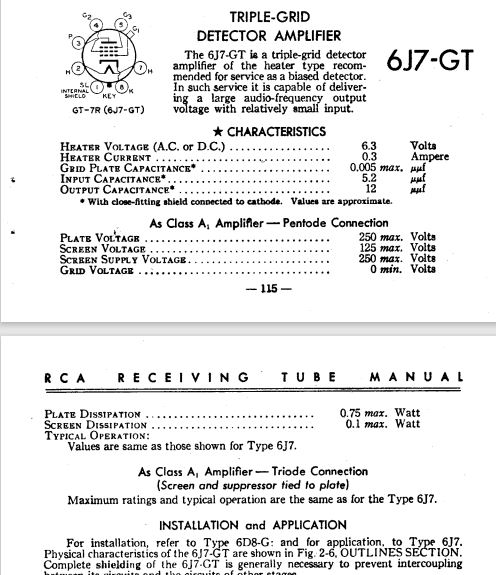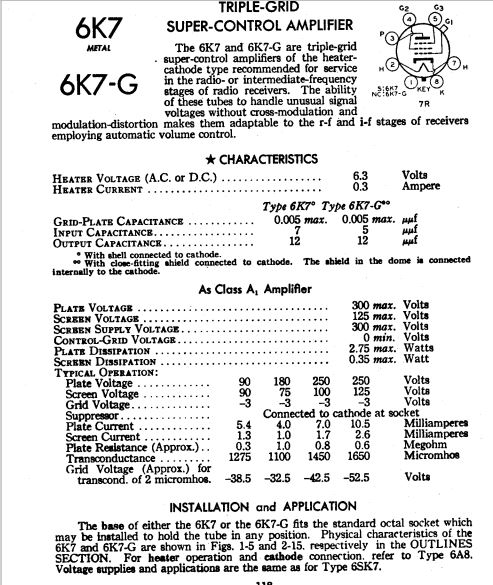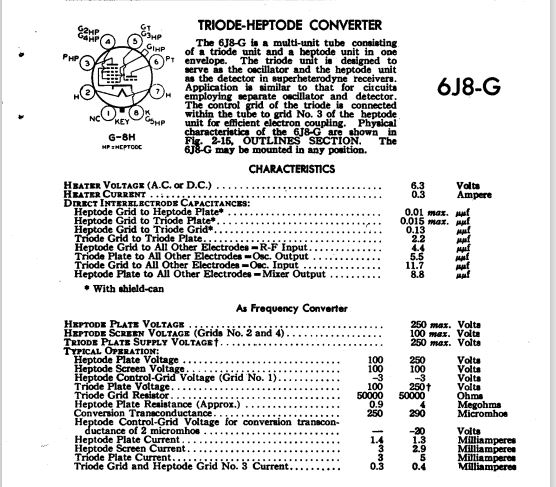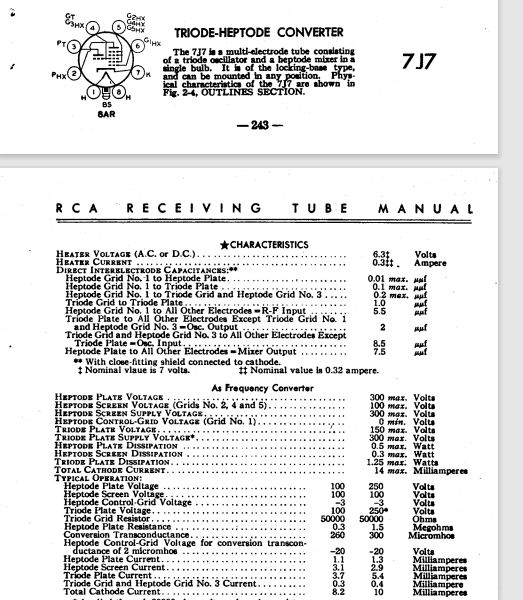01-14-2025, 12:13 PM
Hi Roger,
It sounds like you installed the Bluetooth in the correct place. Short answer to how I would install the "aux input" (Bluetooth, phono, etc.) is to break the connection between capacitor 38 and volume control 41. Use a SPDT switch to select input (radio or Bluetooth). This is similar to what Philco does with radio-phono combinations. They may shut off B+ to the radio section or short the detector output to ground to prevent bleed-through of the radio signal when listening to the aux input but this is not always necessary. Does the sound with Bluetooth fail to meet your expectations or is the issue only with the radio?
I also must apologize that in my previous post, I described the 7J7 as a pentagrid convertor based on my interpretation of the schematic in the Philco library. After consulting the RCA Receiving Tube Manual, I note that the 7J7 is a triode-heptode (a heptode being a tube with a cathode, plate and 5 grids) tube, similar in function to the 6J8 other than the base design and pinouts. The 6K8, a triode-hexode (a hexode being a tube with a cathode, plate and 4 grids) while different in design does the same function. The difference between the triode-hexode or triode-heptode and the Pentagrid or autodyne detectors is that the triode-heptode or triode-hexode provides a "separate electron path" (sharing only the cathode) for the oscillator and mixer with the advantages of having both "tubes" in the same envelope. The Pentagrid Convertor (Heptode) uses a "grid - plate" as the oscillator plate, but the "electron paths" of the oscillator and mixer are the same, passing through all grids.
Does the radio even work with the 6K7 as the convertor (the stage that converts whatever the chosen frequency to the IF frequency)? The 6K7 is a "remote cutoff" pentode, used for RF and IF amplifiers, and is rarely used as a convertor (sometimes referred to as the 1st detector or oscillator mixer). The 6K7 may be used as a mixer when there is a separate oscillator tube, as used in the first generation of superheterodyne radios. The "sharp cutoff" 6J7 was used by Philco on 37-84 "entry level" superheterodyne as an "autodyne" oscillator-mixer 1st detector. This "Autodyne" detector is generally unstable and is not used at high shortwave frequencies. Ever since the introduction of the 2A7, the first "pentagrid" (heptode) convertor tube designed specifically as a combined oscillator-mixer. The heptode (pentagrid convertor) was the most popular form of convertor (Oscillator - Mixer or 1st Detector) used in superheterodyne radios. Other popular Pentagrid Convertors include the 6A7, 6A8, 6SA7, 6BE6 and their 12V equivalents.
One of the Experts or maybe Ron Ramirez coined the term "Franken-Philco" (or is it "Phranken-Philco"), changes made by Philco but not documented. The service notes for the 40-150 and 40-155 from the 1940 Philco Yearbook discuss the substitution of the 7A7 Pentagrid Convertor with the 6J7 but did not publish the circuit. No documentation on this chassis or any Philco chassis of this era having a push-pull output and diode 2nd detector that I have found either in the Philco Library or the Nostalgia Air Website uses a 6K7 either as an oscillator-mixer or as a mixer using a separate oscillator tube.
Note also, that this radio was built between 1939 and 1940. From 1942 to 1946, manufacturing of electronic devices and parts were reserved for the military and parts or tubes for civilian use were scarce, often requiring substitution of a failed tube with either one not ordinarily used bty the manufacturer or a less than ideal substitution which negatively affects the performance of the set.
In the previous post, I posted the circuit diagram of the radio, and the tube pinouts for the 6J8 and 6K8 tubes. Below, I provide the pinouts and description of the 6J7, 6K7, 7G7/1232, 6A8, 6J8 and 7J7 tubes from the RCA Receiving Tube Manual version RC14, ca 1940.





The best advice that I can give about sorting this issue out is to:
It sounds like you installed the Bluetooth in the correct place. Short answer to how I would install the "aux input" (Bluetooth, phono, etc.) is to break the connection between capacitor 38 and volume control 41. Use a SPDT switch to select input (radio or Bluetooth). This is similar to what Philco does with radio-phono combinations. They may shut off B+ to the radio section or short the detector output to ground to prevent bleed-through of the radio signal when listening to the aux input but this is not always necessary. Does the sound with Bluetooth fail to meet your expectations or is the issue only with the radio?
I also must apologize that in my previous post, I described the 7J7 as a pentagrid convertor based on my interpretation of the schematic in the Philco library. After consulting the RCA Receiving Tube Manual, I note that the 7J7 is a triode-heptode (a heptode being a tube with a cathode, plate and 5 grids) tube, similar in function to the 6J8 other than the base design and pinouts. The 6K8, a triode-hexode (a hexode being a tube with a cathode, plate and 4 grids) while different in design does the same function. The difference between the triode-hexode or triode-heptode and the Pentagrid or autodyne detectors is that the triode-heptode or triode-hexode provides a "separate electron path" (sharing only the cathode) for the oscillator and mixer with the advantages of having both "tubes" in the same envelope. The Pentagrid Convertor (Heptode) uses a "grid - plate" as the oscillator plate, but the "electron paths" of the oscillator and mixer are the same, passing through all grids.
Does the radio even work with the 6K7 as the convertor (the stage that converts whatever the chosen frequency to the IF frequency)? The 6K7 is a "remote cutoff" pentode, used for RF and IF amplifiers, and is rarely used as a convertor (sometimes referred to as the 1st detector or oscillator mixer). The 6K7 may be used as a mixer when there is a separate oscillator tube, as used in the first generation of superheterodyne radios. The "sharp cutoff" 6J7 was used by Philco on 37-84 "entry level" superheterodyne as an "autodyne" oscillator-mixer 1st detector. This "Autodyne" detector is generally unstable and is not used at high shortwave frequencies. Ever since the introduction of the 2A7, the first "pentagrid" (heptode) convertor tube designed specifically as a combined oscillator-mixer. The heptode (pentagrid convertor) was the most popular form of convertor (Oscillator - Mixer or 1st Detector) used in superheterodyne radios. Other popular Pentagrid Convertors include the 6A7, 6A8, 6SA7, 6BE6 and their 12V equivalents.
One of the Experts or maybe Ron Ramirez coined the term "Franken-Philco" (or is it "Phranken-Philco"), changes made by Philco but not documented. The service notes for the 40-150 and 40-155 from the 1940 Philco Yearbook discuss the substitution of the 7A7 Pentagrid Convertor with the 6J7 but did not publish the circuit. No documentation on this chassis or any Philco chassis of this era having a push-pull output and diode 2nd detector that I have found either in the Philco Library or the Nostalgia Air Website uses a 6K7 either as an oscillator-mixer or as a mixer using a separate oscillator tube.
Note also, that this radio was built between 1939 and 1940. From 1942 to 1946, manufacturing of electronic devices and parts were reserved for the military and parts or tubes for civilian use were scarce, often requiring substitution of a failed tube with either one not ordinarily used bty the manufacturer or a less than ideal substitution which negatively affects the performance of the set.
In the previous post, I posted the circuit diagram of the radio, and the tube pinouts for the 6J8 and 6K8 tubes. Below, I provide the pinouts and description of the 6J7, 6K7, 7G7/1232, 6A8, 6J8 and 7J7 tubes from the RCA Receiving Tube Manual version RC14, ca 1940.
The best advice that I can give about sorting this issue out is to:
- Please list all the tubes actually installed in this radio. This will help sort out whether this chassis is correct for the cabinet, a substitution. by a similar or a total oddball user-built Phranken-Philco
- To the best of your ability by wire tracing, please confirm that the socket occupied by the 6K7 is actually the convertor socket.
- To the best of your ability, determine if the socket was replaced or rewired. If all sockets except the convertor socket are riveted to the chassis but the convertor socket is attached by screws, it was likely replaced. If the soldering and wiring "job" does not match the rest of the radio in technique and quality, then the socket was likely replaced or rewired.
"Do Justly, love Mercy and walk humbly with your God"- Micah 6:8
"Let us begin to do good"- St. Francis
Best Regards,
MrFixr55



![[-] [-]](https://philcoradio.com/phorum/images/bootbb/collapse.png)


